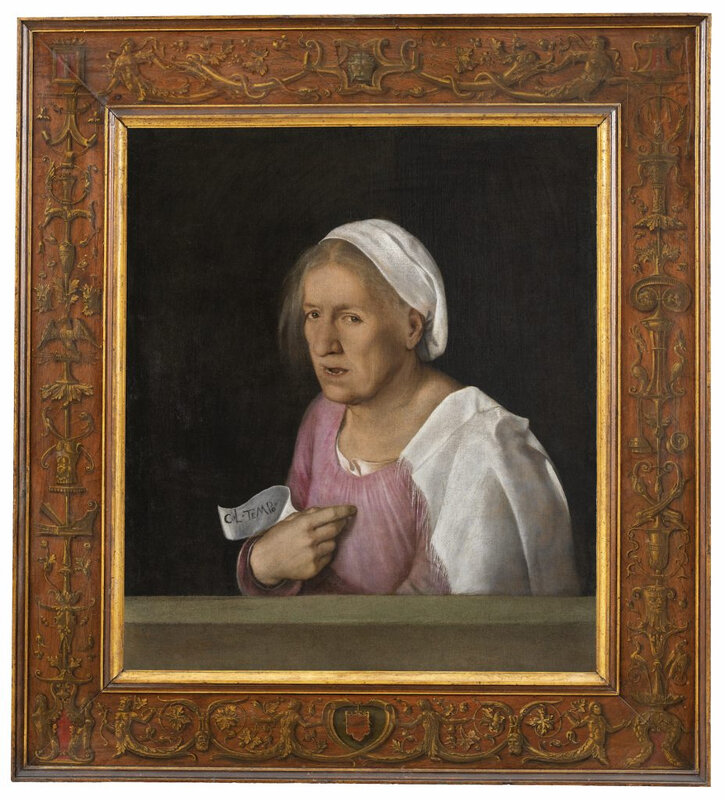Renaissance masterpiece comes to the Wadsworth Atheneum
Giorgione (c. 1477/78–c. 1510), La Vecchia, 1502–08, oil on canvas, 26 3/4 x 23 1/4 in. (68 x 59 cm), Gallerie dell’Accademia, cat. 272, © G.A. VE Photo Archive, Courtesy of the Ministry of Cultural Heritage and Activities—Gallerie dell’Accademia, Venice.
HARTFORD, CONN.- Giorgione's startling allegory La Vecchia (known as The Old Woman) is on view at the Wadsworth Atheneum Museum of Artfrom May 15 to August 4, 2019. Despite the mystery of his biography and the few paintings that can be attributed to him, Giorgione (1474/6-1510) is considered one of the greatest artists of the Venetian Renaissance. With this empathetic painting of an old woman, Giorgione created a portrayal of aging and a reminder of human vanity and the fleeting nature of life. The Wadsworth presents this singular work in conjunction with the Cincinnati Art Museum, due to the initiative of the Foundation for Italian Art and Culture (FIAC), which has facilitated its loan from the Gallerie dell'Accademia in Venice, Italy.
"La Vecchia is Giorgione's poetic response to the natural phenomenon of aging," says Oliver Tostmann, Susan Morse Hilles Curator of European Art of the Wadsworth. "It is a milestone in European portraiture in which Giorgione shows old age with implacable explicitness. It prompts us to confront our own mortality and the inevitable truth of growing old."
The hyperrealistic portrayal of a haggard woman looking directly at us both attracts and repels at the same time. With her lips open as if about to speak, she gestures to herself. In her hand is a slip of paper inscribed with the words col tempo, "with time." Painted more than 500 years ago, the unsparing naturalism and representation of the effects of aging are unexpected, a striking departure from the more familiar, idealized portraits of the time. A recent conservation treatment, funded by FIAC, has removed discoloration and breathed new life into La Vecchia.
Venice around 1500 was a center of cultural and artistic activity where private patronage of the arts thrived. Giorgione was an innovator, introducing new subjects including the nude figure in a landscape, mythological scenes, and sensitive portraits. He is considered one of the leading Venetian painters during the Renaissance, yet he remains one of the most enigmatic. Little is known about Giorgione's life. Born in Castelfranco, he came to fame during the early sixteenth century and died in his early 30s. After experiencing Giorgione's La Vecchia visitors will be invited to view the Wadsworth's collection of Italian works of art including important Venetian Renaissance paintings by artists such as Sebastiano del Piombo, Tintoretto, and Jacopo Bassano. A group of deluxe books designed for and published by the famed Aldus Manutius--Venice's leading purveyor of ancient and modern texts, known for their elegant design--are on view adjacent the Giorgione, as is the museum's Andrea Previtali, Madonna and Child with a Donor in a landscape (c. 1504-05).
"Rarely do we have such a prime opportunity to reconnect with our shared humanity and with the Renaissance," says Thomas J. Loughman, Director and CEO of the Wadsworth. "La Vecchia is without parallel in America as a major allegorical portrait by Giorgione, and this recent conservation provides the perfect occasion to learn and appreciate the ideas behind the painting afresh."

/https%3A%2F%2Fprofilepics.canalblog.com%2Fprofilepics%2F1%2F0%2F100183.jpg)
/https%3A%2F%2Fstorage.canalblog.com%2F03%2F02%2F119589%2F96711876_o.jpg)
/https%3A%2F%2Fstorage.canalblog.com%2F11%2F31%2F119589%2F94773502_o.jpg)
/https%3A%2F%2Fstorage.canalblog.com%2F20%2F83%2F119589%2F94772815_o.jpg)
/https%3A%2F%2Fstorage.canalblog.com%2F26%2F72%2F119589%2F75604929_o.jpg)
/https%3A%2F%2Fstorage.canalblog.com%2F59%2F60%2F119589%2F26458628_o.jpg)



/http%3A%2F%2Fstorage.canalblog.com%2F19%2F64%2F119589%2F121786201_o.jpg)
/http%3A%2F%2Fstorage.canalblog.com%2F08%2F50%2F119589%2F69969169_o.jpg)
/image%2F1371349%2F20240426%2Fob_9bd94f_440340918-1658263111610368-58180761217.jpg)
/image%2F1371349%2F20240426%2Fob_cfa6e3_440317478-1658265314943481-25907527200.jpg)